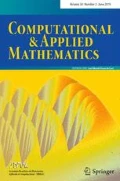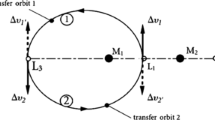Abstract
The objective of the present paper is to study orbital maneuvers to perform a mission to a triple asteroid. First, a genetic algorithm is used to find multi-impulsive maneuvers to go from the Earth to the asteroid, with minimum fuel consumption. After that, swing-by maneuvers with the two smaller bodies of the triple system are simulated and mapped to show the possible gains of energy that can be accomplished with the use of this technique. This study is made using the “patched conics approximation” and the “restricted three-body problem”, to determine the accuracy of the approximated model. The system of asteroids 2001SN\(_{263}\) is used as an example for the calculations.






Similar content being viewed by others
References
Allen JAV (2003) Gravitational assist in celestial mechanics–a tutorial. Am J Phys 71:448–4515
Araújo RAN, Winter OC, Prado AFBA, Sukhanov A (2012) Stability regions around the components of the triple system 2001SN263. Mon Notes R Astron Soc 423:3058–3073
Battin RH (1987) An introduction to the mathematics and methods of astrodynamics. AIAA, New York
D’Amario LA, Byrnes DV, Stanford RH (1982) Interplanetary trajectory optimization with application to Galileo. J Guid Control Dyn 5–5:465–471
Dowling RL, Kosmann WJ, Minovitch MA, Ridenoure RW (1991) Gravity propulsion research at UCLA and JPL. In: 41\(^{st}\) Con. of the IAF, Dresden. GDR., pp 6–12
Farquhar RW, Dunham DW (1981) A new trajectory concept for exploring the Earth’s geomagnetic tail. J Guid Control Dyn 4(2):192–196
Felipe G, Prado AFBA (1999) Classification of out-of-plane swing-by trajectories. J Guid Control Dyn 22(5):643–649
Felipe G, Prado AFBA (2004) Trajectory selection for a spacecraft performing a two-dimensional swing-by. Adv Space Res 34(11):2256–2261
Flandro G (1966) Fast reconnaissance missions to the outer solar system utilizing energy derived from the gravitational field of Jupiter. Astronaut Acta 12–4:329–337
Formiga JKS, Santos DPS (2014) An analytical description of the three-dimensional swing-by. Comput Appl Math 2014:3–18
Formiga JKS, Prado AFBA (2014) Studying sequences of resonant orbits to perform successive close approaches with the Moon. J Braz Soc Mech Sci Eng. doi:10.1007/s40430-014-0254-8
Gomes VM, Prado AFBA (2010) A study of the impact of the initial energy in a close approach of a cloud of particles. WSEAS Trans Math 9:811–820
Gomes VM, Prado AFBA (2008) Swing-by maneuvers for a cloud of particles with planets of the solar system. WSEAS Trans Appl Theor Mech 3:869–878
Helton AF, Strange NJ, Longuski JM (2002) Automated desing of the Europa orbiter tour. J Spacecr Rockets 39:17–22
Hoelker RF, Silber R (1959) The bi-elliptic transfer between circular co-planar orbits. In: Tech memo. Army Ballistic Missile Agency, Redstone Arsenal, pp 2–59
Hohmann W (1925) Die Erreichbarkeit der Himmelskorper. Oldenbourg, Munique
Kresák L (1954) On a criterion concerning the perturbing action of the Earth on meteor streams. Bull Astron Inst Czechoslov 5:45–49
Longuski JM, Williams SN (1991) The last grand tour opportunity to Pluto. J Astronaut Sci 39:359–365
Machuy AL, Prado AFBP, Stuchi TJ (2007) Numerical study of the time required for the gravitational capture in the bi-circular four-body problem. Adv Space Res 40(1):118–124
Petropoulos AE, Longuski JM (2000) Automated design of low-thrust gravity-assist trajectories. In: AIAA/AAS astrodynamics specialist conference, Denver, pp 2000–4033
Petropoulos AE, Longuski JM and Vinh NX (1999) Shape-based analytic representations of low-thrust trajectories for gravity-assist applications. In: AAS/AIAA astrodynamics conference, Girdwood, Alaska, pp 99–337
Prado AFBA, Broucke RA (1995a) A classification of swing-by trajectories using the Moon. Appl Mech Rev 48(11):138–142
Prado AFBA, Broucke RA (1995b) Effects of atmospheric drag in swing-by trajectory. Acta Astronaut 36(6):285–290
Prado AFBA, Broucke RA (1996) Transfer orbits in the Earth-moon system using a regularized model. J Guid Control Dyn 19(4):929–933
Prado AFBA (2005) Numerical and analytical study of the gravitational capture in the bicircular problem. Adv Space Res 36(3):578–584
Prado AFBA (2007) A comparison of the “patched-conics approach” and the restricted problem for swing-bys. Adv Space Res 40(1):113–117
Prussing JE, Chiu JH (1986) Optimal multiple-impulse time-fixed rendezvous between circular orbits. J Guid Control Dyn 9–1:17–22
Radzievskii VV, Tomanov VP (1986) New applications of Tesserand’s criterion. Sov Astron 30:121–123
Santos DPS, Formiga JKS (2014) Application of a genetic algorithm in orbital maneuvers. Comput Appl Math, pp 1–14
Santos DPS, Prado AFBA, Colasurdo G (2012) Four-impulsive rendezvous maneuvers for spacecrafts in circular orbits using genetic algorithms. Math Prob Eng, pp 1–16
Shternfeld A (1959) Soviet space science. Basic Books Inc, New York, pp 109–111
Strange NJ, Longuski JM (2002) Graphical method for gravity-assist trajectory design. J Space Rockets 39:9–16
Striepe SA, Braun RD (1981) Effects of a venus swing by periapsis burn during an earth-mars trajectory. J Astron Sci 39(3):299–312
Sukhanov A, Prado AFBA (2004) Lambert problem solution in the hill model of motion. Celest Mech Dyn Astron 90(3):331–354
Sukhanov A, Velho HFC, Macau E, Winter OC (2010) The aster project: flight to a near-Earth asteroid. Cosmic Res 48(5):443–450
Swenson BL (1991) Neptune atmospheric probe mission. In: AIAA7AAS astrodynamics conference, Hilton Head, pp 92–4371
Szebehely VG (1967) Theory of orbits. Academic Press, New York
Acknowledgments
The authors wish to express their appreciation for the support provided by Grants #473387/2012-3, 473164/2013-2, 304700/2009-6 and 473164/2013-2 from the National Council for Scientific and Technological Development (CNPq); Grants # 2011/08171-3, 2011/13101-4, 2014/06688-7, 2012/21023-6, 2009/16517-7 and 2011/13101-4 from São Paulo Research Foundation (FAPESP) and BEX-10689133 financial support from the Coordination for the Improvement of Higher Education Personnel (CAPES).
Author information
Authors and Affiliations
Corresponding author
Additional information
Communicated by Elbert E. N. Macau, Antônio Fernando Bertachini de Almeida Prado and Cristiano Fiorilo de Melos.
Rights and permissions
About this article
Cite this article
Formiga, J.K.S., dos Santos, D.P.S. Orbital maneuvers to reach and explore a triple asteroid. Comp. Appl. Math. 35, 893–905 (2016). https://doi.org/10.1007/s40314-016-0307-y
Received:
Revised:
Accepted:
Published:
Issue Date:
DOI: https://doi.org/10.1007/s40314-016-0307-y




